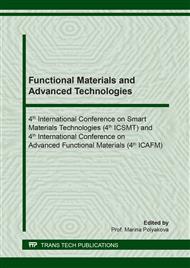p.90
p.98
p.103
p.110
p.115
p.120
p.127
p.132
p.141
Effect of the Filling Pattern on the Compression Strength of 3D Printed Objects Using Acrylonitrile Butadiene Styrene (ABS)
Abstract:
The present study exhibits the behavior of ABS polymer (acrylonitrile butadiene styrene) subjected to mechanical compression tests considering two filling patterns, rectangular and hexagonal; these patterns have been selected due to the geometric arrangement of their internal structure improves the mechanical properties of 3D printed parts, in addition to the increase in tensile strength. The specimens were developed by molten deposition modeling (FDM) under the ASTM D695 standard in 2015, so five samples of each pattern were made; they have an 80% filler material. This is due to the demanding mechanical requirement in engineering applications. The results obtained show that the rectangular fill pattern at 0° and 90° registered the highest compressive strength obtaining as a result an average compression strength of 4 179.92 N, likewise a percentage of deformation of 5.96% and a maximum compressive strength of 33.147 MPa. Because of the evidenced data, the rectangular pattern is useful for engineering and industrial applications, including substituting car parts, machinery or household appliances.
Info:
Periodical:
Pages:
115-119
Citation:
Online since:
March 2020
Price:
Сopyright:
© 2020 Trans Tech Publications Ltd. All Rights Reserved
Share:
Citation:


